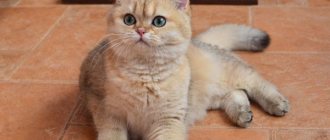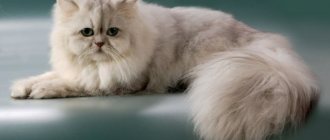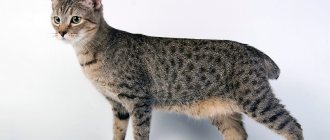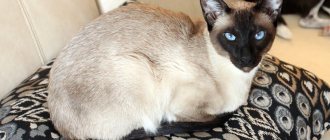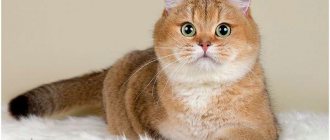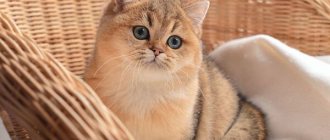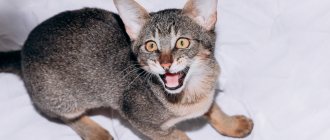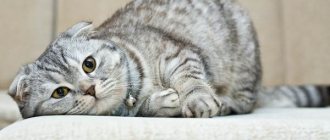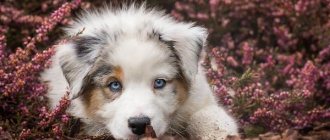Cat breeds bred by UK felinologists are deservedly popular. Both amateurs and professional breeders appreciate the elegance and friendliness of these pets. The modification of the Scots with a characteristic golden color got its name due to the similarity of color with a rodent of the chinchilla family. These uniquely colored pets are not yet very common due to a combination of unfavorable factors. The golden chinchilla cat breed - these representatives are descendants of exotics and Persians, therefore among these cats there are specimens with both long and short hair.
The history of the British chinchilla
The history of the origin of British golden chinchillas still causes a lot of controversy. There are several versions of the origin of these animals. According to the first of them, the ancestors of the chinchilla were brought to Britain from Ancient Rome. Followers of this theory are confident that the British are representatives of ancient cat breeds.
However, another part of the researchers is confident that golden chinchilla cats were bred by crossing with other breeds. Such selection work was carried out directly by English researchers. It is believed that the chinchilla owes its thick coat of beautiful color to the crossing of smoky British cats and Persian-colored cats.
This is interesting. Due to the fact that the British chinchilla was created by crossing short-haired and Persian cats, long-haired kittens can be found in the litter. However, the British Longhair cat must meet the same standards as the British Chinchilla.
Gradually, breeders continued crossing, diluting the new breed with the blood of Tabby cats. Experts managed to obtain a golden color using the method described above. But the basis for genetic experiments was no longer Tabby, but a new breed - the magnificent silver chinchilla.
The expectations of specialists were justified, and at the end of the 19th century an animal was obtained that met the golden chinchilla breed standard. These animals were officially recognized only at the end of the 20th century.
Origin story
The British cat breed was formed at the end of the 19th century, although it took about a hundred years for the official registration of a breed standard. Careful selective selection allowed us to obtain pets with stable health and good character. Many British were born in England, but additional selection of sires was often carried out in Europe or America.
The category of Golden Chinchillas (short-haired, long-haired) appeared as a result of mixing the genetic material of Persian chinchillas and cats with monochrome colors, or British cats with a smoky color.
Photo - Golden chinchilla
The main disadvantage of the offspring resulting from the cross was the lack of stable eye color, ranging from turquoise to yellowish. To stabilize the color of the iris, breeders tried crossing with tabby cats with emerald green eyes. However, such attempts often led to changes in the color of the cats' skin. Therefore, the tactic of inbreeding cats, interspersed with the infusion of Persian genes, was chosen.
The development of the golden cat breed was carried out in accordance with the principles used to produce silver cats. The starting point was an already formed variety of silver chinchillas, and the result was achieved thanks to the gene responsible for the “golden” shade of coat obtained from the Persians.
Description of the Golden British Chinchilla
The basic characteristics of chinchilla cats correspond to the standards of the British Shorthair cat. The difference between these animals is the length and thickness of the fur; representatives of the first breed.
Appearance
British chinchillas are distinguished by a large, wide chest, strong hips and a straight back. In general, their physique is squat, their muscles are well developed. The weight of cats reaches 5-8 kg, cats 3-4 kg.
The breed standard requires compliance with the following appearance features:
- A rounded head with a wide forehead smoothly transitions into a rounded muzzle with round cheeks.
- The nose is straight, short, with a pinkish nose.
- Small ears, rounded at the ends, set wide apart.
- The neck is muscular and short.
- The round eyes are set shallowly. The ideal eye color for chinchillas is emerald, but yellow and blue shades are acceptable.
- The paws are proportional, muscular, but rather short, and therefore give the impression of being stocky.
- The tail is thick and not too long and ends with a rounded tip.
- The coat is short, thick, and the undercoat is well developed.
There are three main color options for chinchilla cats:
- Silver. Recognized as the most common color of the breed. The belly and chest of cats are almost always white, dark areas are localized on the back, sides and tail.
- Gold. The coat of such cats has a delicate peach tint. These pets are also called the British red chinchilla.
- Shaded silver. Compared to the usual silver color, the animal's fur looks darker. In this case, most of the length of the hairs is shaded, and the undercoat remains white.
This is interesting. Among British chinchillas there are color-point individuals. The colors on the ears, paws and tail of these animals are more “Siamese”, and the color of the eyes is blue.
Character
Golden Britons have a calm disposition. These pets are inactive and do not need constant games and physical activity.
Like all representatives of the cat family, the British have an independent disposition and, at the same time, are attached to their owner. Although chinchillas are affectionate, trusting cats and strive to spend as much time as possible near people, they need a separate place to rest.
Due to the lack of aggression on the part of chinchillas, they are often kept in families with children. These furry creatures almost never hiss and, moreover, do not extend their claws. If a golden cat feels irritated, she will simply move away from the place in which she feels discomfort. Golden chinchillas also get along well with other pets, including dogs or other cats.
For your information. Britons are one of the easiest breeds to train. From the first days of being in the house, this cat adopts the rules of the family in which it happens to live. The pet easily gets accustomed to the tray and scratching post.
GOLDEN BRITISH: TYPES OF GOLDEN COLOR BRITISH CATS
The British golden color comes in the following types:
- shaded;
- veiled;
- tabby (ticked, spotted, striped, marbled).
The veiled, shaded and ticked color of the British is also called chinchilla.
| Golden veiled color of British cats | Golden shaded British kitten | Golden ticked British cat |
| Golden spotted British cat | Golden tabby (brindle) color of the British | Golden marbled British kitten |
Contents of a gold Briton
Golden cats of the British breed are suitable for keeping both in a private house and in an apartment. Due to the peculiarities of the coat, shedding in representatives of this breed is almost unnoticeable, especially if it is combed in a timely manner.
Nutrition
Chinchillas can be fed prepared food or natural food.
Important! Under no circumstances should you mix natural food and prepared food. The same prohibition applies to several types of food.
When choosing a dry diet, it is better to focus on super premium or premium classes. Some manufacturers produce lines of food designed specifically for representatives of British breeds, taking into account their needs.
If the owner opted for a natural diet, it should include products such as:
- Raw meat (better lean: veal, turkey). Before serving, it should be placed in the freezer for 12 hours, then doused with boiling water to disinfect it.
- Offal (liver, lungs) boiled or steamed.
- Boiled fish (without bones).
- Low-fat fermented milk products.
- Eggs (preferably quail), 2 times a week.
- Cereals (rice, buckwheat, etc.).
- Vegetables.
The following should be excluded from your pet's diet:
- smoked meats, sausages;
- canned food;
- salty, spicy foods;
- raw milk.
Chinchillas' diet must be balanced. If the animal prefers natural food, vitamin complexes should be added to it from time to time. Drinking water should always be located near the food bowl . It should be changed daily.
How many times a day should you feed your cat?
Chinchillas are prone to overeating and subsequent obesity.
These animals do not know moderation in food, and therefore the dose of delicacy offered to them should be accurately measured. If we are talking about dry food, its quantity must correspond to the data in the table on the package. The amount of natural food is calculated based on the weight and activity of the pet. Leftovers left uneaten by the animal are immediately removed from the bowl. Small kittens eat 6 times a day. Gradually, the number of feedings is reduced, and the animals switch to the feeding regime of an adult cat. The latter are fed 2-3 times a day in small portions.
Walks
The number and duration of promenades depends on the cat's temperament. Some golden pets are content to stay indoors; they are not at all drawn to the street. And other four-legged animals are not at all averse to getting to know the world outside the home.
A chinchilla should be walked on a leash. Before going for a walk, you should take care to protect your animal from parasites. Collars, drops and other means are suitable for this purpose.
Toilet
The golden British chinchilla visits a tray of any size and capacity. Since animals are quite impressive in size, it is better to choose a stable and large toilet for them. Any filler can be used.
Advice. When training a kitten to use the toilet, at first you should purchase the litter that the baby is accustomed to in the nursery. A conscientious breeder, when transferring the baby to a new owner, will provide the latter with all the necessary information.
Appearance care
Complete care for the appearance of a British chinchilla consists of several activities that should be carried out strictly.
Combing
The coat of golden chinchillas includes guard hair and undercoat. Such a multi-level cover needs careful care. Combing is carried out first in the direction of hair growth, and then against the grain. This procedure is performed twice a week, using a special glove or a fine-toothed comb.
Bathing
Despite the fact that the coat of golden chinchillas is quite light, it does not get dirty very often. Therefore, there is no need to bathe your pet often - once every 3 months is enough.
For washing, special shampoos and softening conditioners are used. If there is an urgent need, you can use dry products for washing cat fur, which are selected taking into account the color of the pet.
Ear care
Chinchillas' hearing organs should be carefully examined every 2 weeks. Ear care involves removing dirt and dark plaque using cotton wool. The latter should be moistened with a special composition intended for caring for the ears of cats.
Eye care
The visual organs of British chinchillas require careful care, as they tend to bleed profusely. This process is explained by the original structure of the animal’s tear ducts.
Pets' eyes should be examined regularly to prevent clots from accumulating in the corners. Every morning, the animal’s eyes are wiped with a cotton pad soaked in a solution of boric acid, warm boiled water or a decoction of herbs.
If suppuration is observed, it is permissible to use tetracycline ointment. Progressive eye pathologies require immediate attention to a veterinarian.
Nail care
The claws of golden cats are trimmed once every 2-3 weeks, using special scissors called nail clippers. The pet can remove keratinized particles themselves using a scratching post installed in the room. The latter must be stable and securely fastened.
Dental care
To prevent possible problems with the Briton’s gums and teeth, his oral cavity should be treated once a week. A soft, flexible brush and toothpaste that does not require rinsing are suitable for this purpose.
Purchasing a British Golden Chinchilla kitten
Purchasing purebred British chinchilla kittens is not easy. It is better to choose purebred representatives in trusted nurseries or by contacting reliable breeders who breed this particular breed.
Attention! When purchasing an animal on the market or through a private advertisement, there is a high risk of being deceived and becoming the owner of an ordinary kitten with an unusual color.
Criterias of choice
When choosing a British chinchilla kitten, you should consider a number of recommendations:
- Carefully study the breed standard.
- Make a list of breeders and nurseries. Study reviews about them, become familiar with the peculiarities of keeping animals.
- Be sure to look at the kittens' parents, taking into account their compliance with the breed standard. The breeder will certainly provide a pedigree confirming the purebred of the sires up to the 4th generation.
The immediate choice of a kitten should be approached by paying attention to some features:
- Behavior. When a kitten sees a stranger, it should not try to hide in a corner in horror. A healthy baby is cheerful and inquisitive.
- Appearance. The kittens' coat should be shiny, their eyes and ears should be clean, and their nose should be moist.
- Relevant documents: metrics, pedigree, veterinary book, etc.
At what age is it better to adopt a kitten?
Conscientious breeders hand over kittens to new owners no earlier than 3 months . Babies of this age can already feed themselves and are also trained to use a tray.
Price and reviews about representatives of the breed
The price of a golden chinchilla cat starts from 10,000 rubles if the kitten has a document. If the animal’s pedigree means it will become a show-class pet and confirms this with its exterior, I can ask for 25,000-40,000 rubles. Persians tend to be cheaper, while British and Scots are more expensive.
Reviews about golden chinchillas are as contradictory as the breeds that wear the royal color. The disagreements are mainly related to the nature of the animals. It must be in harmony with the owner's character.
The misconception about the existence of a separate breed of “golden chinchilla” is causing confusion in the minds of pet lovers. Sometimes they expect a British kitten to be agreeable when purchasing a Scotsman.
As for the color of pets, it gives only positive emotions. The owners share that “the sun has appeared” in their house, giving warmth both in the literal and figurative sense.
Breed defects
British chinchillas are not very sick animals, their health is strong. However, genetic diseases that appear as a result of inbreeding are typical for the breed.
Tendency to diseases
British Chinchilla cats may be susceptible to certain diseases, including:
- Retinal atrophy. It is considered a hereditary pathology and can cause decreased vision or loss of vision.
- Polycystic kidney disease. A hereditary disease accompanied by the formation of fluid cysts. At the same time, the quality of blood purification deteriorates, which can provoke intoxication, sepsis and death.
- Hypertrophied cardiomyopathy. Hereditary pathology of the cardiovascular system. Can lead to blockage of blood vessels, pulmonary edema and death of the animal.
You can avoid purchasing a pet with genetic abnormalities by contacting a trusted breeder. At the first alarming symptoms, the cat should be immediately shown to a veterinarian.
Defects in appearance
The following are recognized as serious defects in the appearance of chinchillas:
- thin, sunken cheeks;
- obvious depression on the nose;
- sparse or excessively soft wool;
- high-set ears;
- excessively elongated muzzle;
- flat forehead.
Some shortcomings exclude the British from participating in the competition. These include:
- skeletal deformities;
- deafness;
- blindness;
- anomalies of the eyelids, teeth, jaws.
For your information. Chinchilla coloring has a number of nuances, and certain requirements are imposed on it. Only a specialist can understand the intricacies of animal coloring.
Description of the breed
Golden seals today are in great demand among buyers who are not very versed in the differences. In fact, golden-colored cats may belong to the British or Scottish breed with straight (straight) or fold ears (fold), or to Persians, from which the British inherited the golden color about 50 years ago.
Felinologists studying the causes of the rare coat color have not yet come to a unanimous conclusion. To date, no genetic test has been identified that can link the genome of an animal with the golden color of the skin.
To establish breed characteristics, scientists use a visual comparison technique that takes into account the following characteristics:
- The guard hairs of the coat have a zonal color, with the lower level being colored the color of a ripe apricot. Thanks to this, the pet's undercoat has a light orange tint.
- The upper zone of the guard hairs is colored black in certain proportions (half for tabby colors, one third for shaded colors, 12.5% for chinchillas).
- At the end of the tail, paw pads, nose, lips and corneas of the eyes, the base color predominates.
The most valuable representatives of the breed are distinguished by the maximum saturation of each hair with a bright yellow color. Since many individuals have orange undercoats of varying degrees of brightness, breeding cats with the “golden” gene is particularly difficult, given that the desired gene is not completely dominant, and recessive traits cannot be completely suppressed.
An example is the crossing of specimens with golden and black tabbies, the descendants of which have a gray undercoat and orange guard hairs. The eyes of such kittens are most often colored light green. Thus, to obtain a kitten with the correct golden color, it is necessary that both sires belong to this type.
Quite often, animals with a silver color are used in breeding work, provided that among the ancestors there are the colors of a real Golden Chinchilla. Based on these conditions, British breed chinchillas can be silver, with a hint of silver, or golden, but provided that at least 12.5% of black is present in the upper part of the guard hairs.
Silver or Golden cats are distinguished by bright green eyes, while pets with a silver tint may have slightly yellowish eyes. The breed standard allows small black spots, including charcoal paw pads, dark edging of the nose and eye.
The standards allow partial coloring of the cat, when the upper surfaces of the pet’s body are darkened, and the tummy, chest and chin shine with golden shades.
The remaining distinctive features must fully coincide with the standards provided for British cats: developed muscles, powerful neck, flat back, large hips, powerful paws, wide tail with a curved tip.
Males of this species can be easily identified by their rounded cheeks. Like other British cats, cats are distinguished by round, expressive eyes and dense, thick fur.
Summarizing the characteristic features, Golden Chinchillas can be characterized using the following characteristics:
- powerful build, muscular chest, straight back;
- limbs of medium length;
- round paw pads with woolen bushes between the toes;
- small head with a rounded chin;
- a flattened small nose, colored pink or brick;
- large eyes with a greenish-copper iris, outlined in dark (the point chinchilla has blue);
- short straight ponytail, rounded at the end;
- weight from 4.5 to 8 kg.
In recent years, the original variety of Golden Chinchilla – “point”, which is characterized by deep sapphire-colored eyes outlined with a charcoal “tattoo”, as well as black paw pads and nose, has enjoyed increasing success. Such signs are explained by the fact that the Golden Point Chinchilla belongs to black cats. At the same time, cats in this category can be classic chinchillas, or have a shaded color the color of baked milk.
Breeding the British Chinchilla breed
Breeding British chinchillas is quite a complex matter. For this reason, it is recommended that only experienced breeders engage in it.
Criteria for choosing a partner
Finding a suitable pair for a chinchilla is quite problematic due to the small number of the breed. The offspring are characterized by deviations in color, and therefore crossing is carried out by a limited number of individuals and only among the chinchilla variety.
A potential mating partner must meet certain criteria:
- absence of gene pathologies;
- availability of the necessary documents: veterinary passport, pedigree, breeding permit, etc.;
- deworming, vaccination (must be carried out 2-3 weeks before mating).
The chosen "groom" or "bride" must correspond to the characteristics of the breed, especially with regard to coloration.
At what age should you give your pet for the first mating?
British chinchillas reach sexual maturity late. In view of this, mating should begin when the pet is 20-24 months old. Excessively early birth will not have the best effect on the cat’s immature body. In addition, the offspring in this case often turns out to be weak or non-viable.
